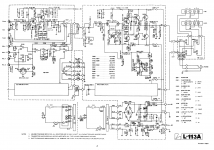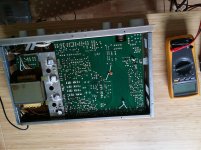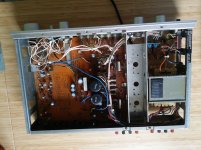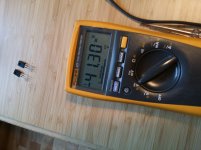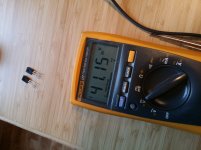I am attenpting to repair the Luxman A-113A but my knowledge are somehow limited.
The problem is the left channel distorts. when I tried to bias the left channel the current was going up and down like crazy never getting a constant value.
I start measuring some values according to the service manual and notice the NPN driver was mad hot. measuring the base I get 0,8v and in the service manual points to 1,2v. I tried to replace the transistors already but the behave keeps beeing the same.
can you give me any tips here to measure next and identify the cause?
The problem is the left channel distorts. when I tried to bias the left channel the current was going up and down like crazy never getting a constant value.
I start measuring some values according to the service manual and notice the NPN driver was mad hot. measuring the base I get 0,8v and in the service manual points to 1,2v. I tried to replace the transistors already but the behave keeps beeing the same.
can you give me any tips here to measure next and identify the cause?
Attachments
Start by checking the power supply voltages.
Thank you rayma for the advice.
I checked and I have +41v and -41v in each rail (posted some photos). a bit lower than the service manual says ~43v. The ac input is 228v in my grid and before the rectifiers diodes it measures 30v AC.
I talked with the owner of the amplifier and he said that the speaker cable shorted with the chassis of the unit, which made the main fuse blow. After replacing the fuse, the right channel seems to work just fine (although was repaired previous by someone who changed the driver transistors) but the left is misbehaving with a lot of distortion and heating up a lot the npn driver transistor.
I went a bit further and desoldered back the transistor drivers and the power transistors. the drivers seem good when I tested with my diode check function on the multimeter. The NPN power transistor has a short from the base emitter junction
Is there something more I can check before finding a replacement power transistor?
Also any advice as a replacement for the 2sc2577?
Cheers guys

Attachments
In that case you'd probably better change both the NPN and PNP... but before you do that, also check the drivers... they might have suffered damage too.The NPN power transistor has a short from the base emitter junctionthe PNP seems fine with around 0,6 drop voltage between be and bc and no short on the ce pins.
Is there something more I can check before finding a replacement power transistor?
Also any advice as a replacement for the 2sc2577?
Cheers guys
On replacement: notice that both transistors have an ft of 20 Mhz. Your replacements ought to have (about) the same ft too.
Last edited:
In that case you'd probably better change both the NPN and PNP... but before you do that, also check the drivers... they might have suffered damage too.
On replacement: notice that both transistors have an ft of 20 Mhz. Your replacements ought to have (about) the same ft too.
I have new drivers to replace (KSA1220AYS/KSC2690AYS) but apparently the original ones are in order. I will take the opportunity and match the also the right channel because someone made a repair before and put some bc and bd transistors plus some bad solder joints.
The 20mhz you mean the bandwidth gain? ft means frequency transient or so? should I pick the same or higher value of response? soorrry for so many questions but still trying to understand all the values to look out for,
I have a Lux L-114A and I bought NJW0281G/NJW0302G for it in case its output transistors ever break. Because I could not get the originals from reliable stockists any more. There are 2SC2577/2SA1102 on ebay but I am not trusting them.
I saw them on ebay and ordered two pairs
If I don't get lucky, I will go for your suggestion NJW0281G/NJW0302G

ft is the transient frequency of the transistor.The 20mhz you mean the bandwidth gain? ft means frequency transient or so? should I pick the same or higher value of response? soorrry for so many questions but still trying to understand all the values to look out for,
I saw them on ebay and ordered two pairskinda regret that I didn't wait for your answer. let's see the outcome, they are quite inexpesive.
If I don't get lucky, I will go for your suggestion NJW0281G/NJW0302G
On selecting parts with a higher ft? I'm not sure... it might increase the risk of oscillations in the power stage. Unless you know exactly what you're doing and have the equipment to keep everything in check, I wouldn't select much faster transistors.
ft is the transient frequency of the transistor.
On selecting parts with a higher ft? I'm not sure... it might increase the risk of oscillations in the power stage. Unless you know exactly what you're doing and have the equipment to keep everything in check, I wouldn't select much faster transistors.
I will have an eye for the transient frequency. I know what I am doing till certain point, learning by doing
Thanks for all the help

ft is the transition frequency, not transient frequency. Its the nominal frequency at which current gain falls to unity, though its actually measured as gain-bandwidth product at a lower frequency in practice. I think the name refers to the idea of the device transitioning from amplifying to attenuating.
- Status
- This old topic is closed. If you want to reopen this topic, contact a moderator using the "Report Post" button.
- Home
- Amplifiers
- Solid State
- Help reparing Luxman L-113A
